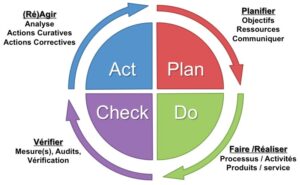In France, companies continue to neglect ISO 14001 certification. Difficult to implement by the rigour and involvement it requires, it nevertheless has the advantage of mobilising and bringing together employees around a value promoting approach. We bring you this article so you can learn more and see where you are at.
I / ISO 14001 standard definition
A series of standards, called ISO 14000, focus on environmental management in particular. The most commonly used in this series, ISO14001 standard, does not include any requirements in terms of performance. Based on a voluntary approach, it relies on the continuous improvement method, through the management and reduction of the company’s activity on the environment. The method of action is determined freely.
ISO 14001 standard is based on the Deming cycle.

Created by the International Organization for Standardization (ISO), it is intended to provide for continuous improvement of the company’s performances. Several bodies grant this certification: the association française pour l’amélioration et le management de la qualité (AFAQ), Bureau Veritas (BVQI), Det Norske Veritas (DNV) certification France, Ecopass, Lloyd’s Register Quality Assurance (LRQA), SGS-ICS, UTAC, Dekra certification and the organisme français de certification (OFC).
II / Its requirements
There are 18 and they are divided into 6 chapters:
1. General requirements: covering the company’s intentions in terms of the environment.
2. The environmental policy: the objectives set by the company.
3. Planning: pools actions planned to meet the environmental policy.
4. Implementation: this is effective planning monitoring
5. Controls and corrective action: they relate to monitoring of running of the Environmental Management System
6. The management review: it concerns verification of the compatibility, efficacy and relevance of the system
III / Essential implementation steps
An audit of the current practices and of their compliance or non-compliance with legislation and the set objectives is always the first step to be taken. It is used to assess the company’s performance in terms of environmental management and to identify the improvements necessary. The audit can include a greenhouse gas emission assessment: it is thus necessary to refer to ISO14064 standard. If the audits are conducted internally, a consultant from one of the certification bodies cited above will complete it.

The second step consists of the creation of a programme of measures to be taken and actions to be developed according to the relevant schedule. This may include for example better management of paper resources.
Finally, the company’s new practices and their environmental impact will be assessed on the basis of one yearly audit, for a three year period. New changes may be necessary.
IV / The 5 advantages of conforming
The first obviously concerns the more effective management of environmental issues in the company’s overall management, in the same way as quality and safety. By imposing a regulatory watch system, ISO 14001 standard offers companies better financial management of this concern.
As a cost management tool, the environmental management system, via prevention actions, prevents incidents and minimises their impacts. Improved consumption and discharge-waste sparing provides for a return on investment. A dialogue tool, it ensures the trust of partners and customers, investors, residents, environment protection organisations and insurance agencies alike.
Also taking the form of a tool for rallying employees, it unites staff by offering them a joint project. It is all the more useful where it concerns direct improvement of their work environment, especially in terms of health and safety. Tangible results maintain motivation.
Finally, the success of this project can improve the company’s image in everyone’s eyes.
Even if standard ISO 14001 raises the awareness of companies to a real CSR approach, it remains strongly criticised. In effect, as it does not mention any obligations concerning sustainable development, some remain sceptic as to its efficacy. Do not hesitate to take your approach further within your company.